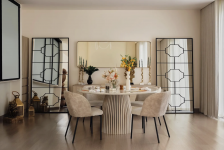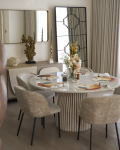In a world that glorifies abundance, stillness has become a quiet form of rebellion.
Stillness in design is not emptiness - it is intention. It is about creating spaces where the mind can pause, where silence feels designed, not accidental.
At Danza Del Design, minimalism isn’t treated as a style, but as a philosophy. Every project begins with a question: what truly belongs, and what can be left out?
Because when we subtract the unnecessary, we make room for emotion, light, and clarity to enter.
Stillness doesn’t mean a lack of presence - it is presence.
In every Danza project, the aim is not just to create a minimal space, but a meaningful one.
It’s not about less - it’s about essence.
When everything unnecessary is removed, what remains is what truly matters: light, texture, proportion, and emotion.
And that, perhaps, is the highest form of design - spaces that ask for nothing, yet give you everything.
The Essence of Stillness
Stillness in interiors is more than visual calm. It’s the balance between form and feeling, structure and softness.
A still space doesn’t demand attention - it rewards it. It allows details to breathe, materials to speak, and people to exist comfortably within them.
Think of a living room with muted tones and clean geometry, where the sunlight gently shifts across pale stone flooring. Nothing shouts, yet everything resonates.
This quiet dialogue between material and atmosphere forms the essence of Danza’s approach - spaces that calm without dullness, that soothe without sterility.
Stillness, when designed well, becomes magnetic. It draws people in, not through excess, but through depth.
The Language of Restraint
Restraint is not about deprivation - it’s about discernment.
At Danza Del Design, restraint begins with purpose. Each line, surface, and junction must justify its existence. Nothing is decorative for the sake of decoration.
A console may float off the floor to create visual lightness. A muted palette might be paired with one tactile accent - say, linen against brushed brass - to offer quiet contrast.
This careful curation of elements builds rhythm and focus. It’s what transforms simplicity from plainness into poetry.
When space is stripped to its essentials, even shadow becomes a design tool. It softens geometry, adds dimension, and infuses life into stillness.
2025
2025
The Essence of Stillness
Stillness in interiors is more than visual calm. It’s the balance between form and feeling, structure and softness.
A still space doesn’t demand attention - it rewards it. It allows details to breathe, materials to speak, and people to exist comfortably within them.
Think of a living room with muted tones and clean geometry, where the sunlight gently shifts across pale stone flooring. Nothing shouts, yet everything resonates.
This quiet dialogue between material and atmosphere forms the essence of Danza’s approach - spaces that calm without dullness, that soothe without sterility.
Stillness, when designed well, becomes magnetic. It draws people in, not through excess, but through depth.
The Language of Restraint
Restraint is not about deprivation - it’s about discernment.
At Danza Del Design, restraint begins with purpose. Each line, surface, and junction must justify its existence. Nothing is decorative for the sake of decoration.
A console may float off the floor to create visual lightness. A muted palette might be paired with one tactile accent - say, linen against brushed brass - to offer quiet contrast.
This careful curation of elements builds rhythm and focus. It’s what transforms simplicity from plainness into poetry.
When space is stripped to its essentials, even shadow becomes a design tool. It softens geometry, adds dimension, and infuses life into stillness.
Material as Meditation
Minimalism isn’t about removing richness - it’s about refining it.
Every material in a Danza project is chosen for how it feels, not just how it looks. A honed marble top that cools to the touch, a matte wall finish that absorbs light gently, or a solid wood joinery that ages with grace.
These materials tell stories slowly. Their textures shift subtly through the day, creating an ever-changing quietness.
In this way, materials become meditative - reminding us that simplicity doesn’t mean absence; it means awareness.
The Spatial Rhythm of Calm
Stillness is also spatial. It’s about proportion, balance, and flow.
A corridor that opens to an unexpected courtyard, a low ceiling that transitions into double-height openness—these spatial rhythms mirror the tempo of human emotion.
At Danza Del Design, layouts are choreographed for ease and movement. Pathways are uncluttered, transitions are soft, and visual sightlines are carefully composed.
The result? A sense of calm continuity. You don’t walk through these spaces - you glide.
This is the quiet luxury of proportion: it makes architecture feel effortless.
Emotion in the Pause
When design is quiet, emotion becomes audible.
Stillness allows us to reconnect - with our senses, our thoughts, and the present moment.
A home with stillness invites mindfulness; a hospitality space with stillness invites pause.
For Ridhima Singh, this emotional clarity is the truest expression of luxury. “Stillness,” she often says, “is the most generous design gesture - it gives people back their focus.”
Danza Del Designs









